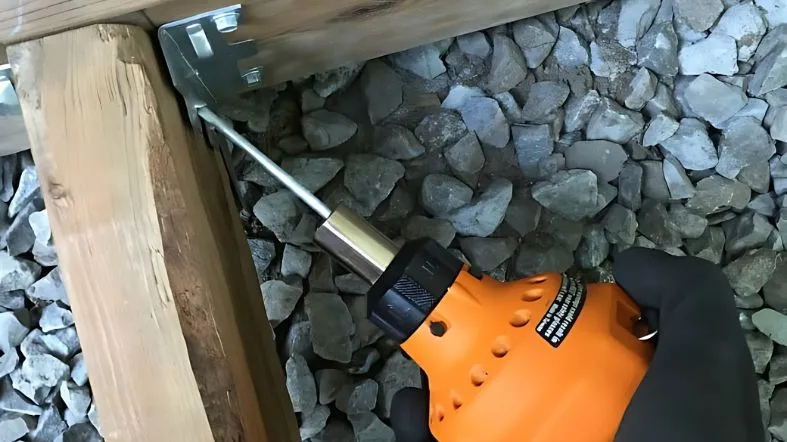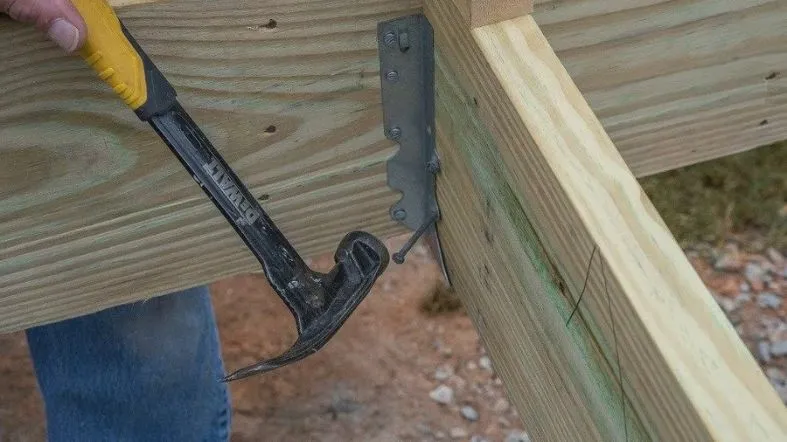Joist hangers are essential for ensuring a secure and long-lasting connection between the joist and the beam or ledger.
Choosing the right nail size is crucial for ensuring that the hanger can carry the intended load. So, what size nails for joist hangers?
This blog will guide you through the process, helping you avoid common mistakes and understand the factors to consider when selecting nails for joist hangers.

What Size Nails for Joist Hangers?
For joist hangers, it’s generally recommended to use 10D or 16D galvanized nails or nails that are specifically manufactured for the hanger. The nail size may vary depending on whether you’re attaching the hanger to the joist or the ledger board, and the type of lumber.
Quick Nail Size Chart for Joist Hangers:
| Joist Hanger Type | Nail Size for Joist | Nail Size for Ledger |
|---|---|---|
| Light-Duty | 8d – 10d | 10d |
| Standard-Duty | 10d | 10d – 16d |
| Heavy-Duty | 12d – 16d | 16d |
| Sloped/Skewed | 10d | 10d – 12d |
| Double Joist | 10d | 12d – 16d |
Different Types of Nails Suitable for Joist Hangers
There are several types of nails you can use for joist hangers:
Common Nails
Common nails are often used for joist hangers because they are strong and easy to find. They have a smooth shank and a flat head, which makes them a good choice for many construction projects.
For example, if you’re building a treehouse, common nails could be used to secure the joist hangers to the tree.
Spiral-Shank Nails
Spiral-shank nails are another great option for joist hangers. Their twisted shank design provides extra holding power, making them ideal for projects that require a strong bond.
Imagine you’re building a deck; the spiral-shank nails would ensure the joist hangers stay firmly attached to the deck frame.
Ring-Shank Nails
Ring-shank nails have rings along their shank that create friction against the wood, providing strong holding power.
This makes them an excellent choice for projects where the wood may be exposed to movement or stress.
For instance, if you’re constructing a swing set, ring-shank nails would help keep the joist hangers securely in place.
Stainless Steel Nails
Lastly, stainless steel nails are resistant to corrosion, making them ideal for outdoor projects where they may be exposed to weather elements.
If you’re building an outdoor pergola, stainless steel nails would be a good choice for attaching the joist hangers, as they can withstand rain and humidity without rusting.
Why the Right Nail Size Matters for Joist Hangers?

Choosing the right nail size is important for several reasons:
Structural Integrity
Choosing the right nail size is crucial for the structural integrity of your project.
For instance, if you’re building a wooden deck, using the correct nail size will ensure the joist hangers are securely fastened, providing a sturdy and reliable structure.
Safety Concerns
Safety is paramount in any construction project. Using the wrong nail size can lead to safety issues.
Imagine if a joist hanger fails under load because of a too-small nail; it could cause the entire structure to collapse.
Longevity of the Construction
The right nail size can also increase the lifespan of your construction project.
For example, if you’re constructing a treehouse, using the appropriate nail size for the joist hangers will ensure the treehouse remains safe and secure for many years to come.
Compliance with Building Codes
In many areas, local building codes specify the type and size of nails that must be used for certain applications, including joist hangers.
Using the correct nail size ensures your project complies with these codes. For example, if you’re building a porch, using the right nail size for the joist hangers will help ensure your project passes any necessary inspections.
Ease of Installation
The right nail size can also make the installation process easier and more efficient. If you’re using a nail that’s too large, it could split the wood; if it’s too small, it might not hold the joist hanger securely.
By choosing the right nail size, you’ll make the installation process smoother and quicker.
Cost Efficiency
Lastly, using the correct nail size can be more cost-efficient. If you use nails that are too large, you might waste money on unnecessary materials.
On the other hand, if your nails are too small and fail to secure the joist hangers properly, you might need to redo some parts of your project, which could also lead to additional costs.
So, choosing the right nail size from the start can save you both time and money in the long run.
How to Determine the Right Nail Size for Joist Hangers

Identifying the Load-Bearing Capacity of Your Joist Hangers
First things first, look at your joist hanger packaging. It will have a label that tells you the load-bearing capacity. The load-bearing capacity is how much weight the joist hanger can safely hold.
Don’t skip this step, because it’s super important! If your treehouse weighs 300 pounds, and the joist hanger can only hold 200 pounds, that’s a problem!
Let’s say the label on your joist hanger reads “Max Load: 500 lbs.” That means the hanger can safely hold up to 500 pounds.
Checking the Wood You’re Using
Knowing the type of wood you’ll be using is key. Softwood, like pine, and hardwood, like oak, need different nail sizes.
Always check the instruction manual or guidelines for your wood type. This will help you find the right nail size. Also, remember that hardwood generally needs smaller but stronger nails.
If you’re using pine wood, which is a softwood, the guidelines might recommend a bigger but less sturdy nail.
Assessing Your Project’s Needs
Now, think about what you’re building. A treehouse will need more support than a bookshelf. The bigger the project, the more load it will carry, and the stronger the nails you’ll need.
If you’re building a deck, you’ll need strong nails to hold up all the people, furniture, and maybe a grill!
Types of Nails Suitable for Joist Hangers
There are usually two kinds of nails you’ll consider for joist hangers: common nails and joist hanger nails. Joist hanger nails are shorter and thicker.
Common nails are longer but thinner. Your project and wood type will help you decide.
For a treehouse made of pine wood, you might use joist hanger nails because they offer sturdy support.
Matching Nail Size to Joist Hanger Holes
Your joist hanger will have holes where the nails go. Measure these holes or check the guidelines to find out the nail diameter that fits. Never use nails that are too big or too small. If it’s a tight fit, that’s good!
If the holes in the joist hanger are 0.131 inches in diameter, look for nails that fit snugly into these holes.
The Length of the Nails
Last but not least, check the length of the nails. Longer isn’t always better! You want the nail to go deep enough into the wood for a strong hold but not so deep that it comes out the other side.
For a deck with thick wood beams, maybe you’d use 3-inch nails, but for a lighter project like a birdhouse, 1.5-inch nails could be enough.
Factors to Consider When Selecting Nails for Joist Hangers
Material of the Joist
Different materials require different nail sizes. For instance, a hardwood joist might need a longer nail for secure fastening, while a softwood joist might require a shorter nail.
Type of Load (Static or Dynamic)
The type of load the joist will bear also influences the nail size. A dynamic load, like a swing set, may require larger nails to ensure stability.
Building Codes and Regulations
Always follow local building codes and regulations when selecting nails for joist hangers. These codes often specify the type and size of nails that should be used.
Corrosion Resistance
If your project is outdoors, choose nails that resist corrosion. For example, stainless steel nails are a good choice for outdoor projects as they can withstand weather elements without rusting.
Climate and Weather Conditions
Certain climates may require specific types of nails. In a humid climate, for instance, you might need to use galvanized nails that can resist rusting.
Budget Constraints
Lastly, choose nails that fit within your budget. While it’s important to select high-quality nails, it’s also necessary to consider the cost. Remember, the most expensive option is not always the best one.
How to Properly Install Nails in Joist Hangers

Marking the Position for Your Joist Hangers
Start by measuring where the joist hangers will go on your wood beam. Use a pencil to mark these spots. Remember, spacing is crucial for even support.
If you’re making a deck and the blueprint says joist hangers should be 16 inches apart, use a ruler to mark every 16 inches.
Aligning the Joist Hanger with the Wood
Place the joist hanger against the wood where you made your pencil marks. Hold it steady! Make sure the top flange lines up with the top of your wood beam.
When installing a joist hanger for a treehouse floor, the top of the hanger should be flush with the tree limb you’re attaching it to.
Pre-Drilling Holes
Grab a drill and make small guide holes in the wood through the holes in the joist hanger. Pre-drilling helps the nails go in easier and reduces wood splitting. Always wear safety goggles.
For softwood like pine, use a drill bit slightly smaller than your nail diameter to make the pre-drilled holes.
Inserting the First Nail
Place the first nail in one of the guide holes you just drilled. Tap the nail gently with a hammer to set it in place. Just a couple of taps will do. You don’t want to drive it in yet.
If you’re using a 1.5-inch joist hanger nail, lightly tap it until about a quarter-inch goes into the wood.
Driving the Nails into the Joist Hanger
Hold the hammer firmly and drive the nail in. Swing your hammer in a controlled motion. The nail should sink deep into the wood but not poke out the other side.
If you’re building a shelf, make sure the nail goes deep enough to hold the weight of books or other items.
Securing Additional Nails
Once the first nail is in, proceed to hammer in the remaining nails. Each hole in the joist hanger should get a nail unless the instructions say otherwise.
For a deck project, you might need to hammer in four nails on each side of the hanger for extra support.
Double-Check the Installation
After all nails are in, give them a little shake to ensure they’re snug. Look closely. If you see any nails that appear loose, tap them in a little more.
If you’re installing a swing set, this step is vital. A loose nail could lead to an unstable swing.
Using Galvanized or Stainless Steel Nails
Always opt for galvanized or stainless steel nails for outdoor projects. These nails resist rust, providing long-lasting support.
For an outdoor chicken coop, using galvanized nails can ensure your hens have a sturdy home for years.
Finishing Up with a Builder’s Level
Use a builder’s level to make sure the joist hangers are perfectly horizontal. If they’re off even a bit, your structure won’t be stable.
When making a picnic table, use a level to check. A slanted table will make your barbecue sauce slide off your burger, and nobody wants that!
Common Mistakes to Avoid When Using Joist Hangers
Using the Wrong Nail Size
One common mistake is using the wrong nail size for joist hangers. This can compromise the structural integrity of your project.
For example, using nails that are too small might not provide enough support, while nails that are too large could split the wood.
Ignoring Manufacturer’s Guidelines
Another mistake is ignoring the manufacturer’s guidelines for the joist hangers. These guidelines provide important information about the type and size of nails to use.
Not following these guidelines could lead to a weak connection or even a structural failure.
Not Checking Building Codes
Failing to check local building codes is another common error. Building codes often specify the type and size of nails that should be used for certain applications, including joist hangers.
Ignoring these codes could lead to your project not being up to standard, or even unsafe.
Overlooking Corrosion Resistance
If your project is outdoors, it’s important to choose nails that resist corrosion. Overlooking this factor and using nails that rust easily can shorten the lifespan of your project.
Neglecting Climate and Weather Conditions
Lastly, neglecting to consider the climate and weather conditions in your area is a mistake. Certain climates may require specific types of nails.
For instance, in a humid climate, you might need to use galvanized nails that can resist rusting.
FAQs
Can I use common nails for heavy-duty joist hangers?
Is it mandatory to pre-drill holes for joist hangers?
Are galvanized nails suitable for all outdoor projects?
Do I need to fill every hole in the joist hanger with a nail?
Are ring-shank nails suitable for dynamic loads like swing sets?
Conclusion
Choosing the right nails for joist hangers is crucial for safety and structural integrity. Always follow the manufacturer’s recommendations and local building codes. Happy building!
